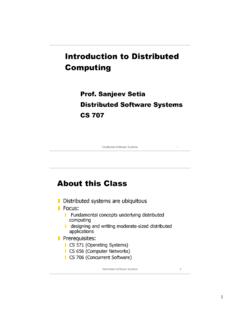Transcription of STRATEGIC COMMUNICATIONS PLAN
1 STRATEGIC COMMUNICATIONS PLANO ffice of the Executive Vice Chancellor and ProvostTABLE OF CONTENTSE xecutive Summary0304 Methods05 Situational Analysis09 Audience Analysis16 Key Messages17 Supporting Facts21 communication Goals22 Objectives, Tactics, Metrics and Priorities31 Universitywide COMMUNICATIONS and Technology Considerations33 Appendix3 Executive SummaryThe Office of the Executive Vice Chancellor and Provost s STRATEGIC COMMUNICATIONS plan is a road map that will guide Provost s Office COMMUNICATIONS with the university community in a way that is open, transparent and forward thinking. It was developed by a working group and advisory committee within the Office of the Provost, with extensive input from stakeholders across NC State s campus and guidance from University plan is focused on five main goals: Goal 1: Build Awareness Increase knowledge about the office, its role and the breadth of resources it provides to faculty, students and staff as the academic heart of the university community.
2 Goal 2: Evaluate, Update and Innovate COMMUNICATIONS Assets and Processes Understand and define opportunities for Provost s Office communication improvements in both day-to-day and STRATEGIC COMMUNICATIONS . Improve communication processes and assets. Goal 3: Become the Go-To Faculty Resource and Advocate On Campus Build and support the Provost s Office image as the authoritative resource and advocate for faculty and academic administrators on campus. Goal 4: Define the Culture, Image and Brand of the Office Build a culture of open, transparent and dialogic COMMUNICATIONS between the Provost s Office and the university community.
3 Goal 5: Provide COMMUNICATIONS Leadership for University STRATEGIC Initiatives Provide primary COMMUNICATIONS oversight for STRATEGIC planning, including processes and metrics, as well as for designated university STRATEGIC tactics outlined in the plan seek to improve internal COMMUNICATIONS , an area that stakeholders repeatedly identified as needing improvement. In addition, identified tactics will bring office COMMUNICATIONS in line with the new NC State brand. openness and transparency are themes that resonate throughout the recommended tactics in an effort to provide more access and clarity to the programs administered through the Office of the plan was informed by numerous stakeholders across campus.
4 Specifically, we engaged: Deans via the Council of Deans Focus groups of staff, faculty and administrators (four focus groups totaling 32 people) Focus group of deans administrative assistants Focus group of university communicators across campus Faculty Senate Vice Provosts via Vice Provosts meeting Provost Office staff via multiple group discussions and meetingsSummaries of focus groups and feedback received can be found in the AnalysisBackgroundThe work of the Provost s Office covers tremendous scope within NC State and provides immense value to the institution. The Executive Vice Chancellor and Provost serves as the chief academic officer for NC State, and the Provost s Office has ultimate responsibility for and oversight of the university s 10 colleges.
5 This includes executive-level administrative responsibilities such as leadership searches, program reviews and carrying out directives from the chancellor, UNC General Administration and the UNC Board of Governors. The Provost also oversees and provides STRATEGIC vision to 11 critical corollary units, including: the Graduate School, Enrollment Management and Services, Institutional Research and Planning, the Division of Academic and Student Affairs, NCSU Libraries, Faculty Affairs, Institutional Equity and Diversity, Continuing Education, Distance Education and Learning Technologies Applications, Outreach and Engagement, and International addition to its primary role, the Provost s Office is responsible for leading the development and implementation of the university STRATEGIC plan and for the successful implementation of high-level university initiatives, such as the Chancellor s Faculty Excellence Program and the University Faculty Scholars awards.
6 These key initiatives are raising NC State s visibility nationally and internationally. Major Responsibilities and Initiatives Development and implementation of universitywide academic policies, rules and regulations Assistance with development and review of academic programs Oversight and facilitation of searches for administrators, deans and vice provosts Oversight and management of university standing committees Promotion and tenure process management Academic and administrative oversight of 10 colleges Oversight of vice provost units (see appendix for organizational chart) Facilitation of academic interdisciplinary programs Ensuring faculty and student success Oversight of faculty development office Oversight and deployment of university s STRATEGIC plan Chancellor s Faculty Excellence Program University Faculty Scholars Awards Assistance with STRATEGIC resource management Leadership of university s charge to create a culture of diversity and inclusion Spearheading university task forces and working groups for select initiatives Support university affairs committee of the Board of Trustees Administration and oversight of select awards for faculty Facilitation of faculty
7 Recruitment and retention Coordination of tuition and fee approval process Provost serves as key university representative and speaker6 The enormous breadth of work coming out of the Provost s Office is overseen by a core group of 15 faculty and staff members ranging from senior vice provosts to administrative support. At the office s helm is Dr. Warwick Arden, who has been Provost since December 2010. The office s dedicated staff and solid leadership have directly influenced the tremendous growth, success and positive reputation that NC State has garnered in the last five general anecdotal impression of the Office of the Provost and its staff among the campus community is one of great competence and efficiency.
8 However, there is a general lack of awareness and understanding about the breadth of the role the Provost plays in the success of NC State. For the office to be more widely recognized as the central resource hub for collaboration, integration and facilitation of key STRATEGIC initiatives for the university, its overall visibility must be raised, especially with regard to its and ChallengesUniversity COMMUNICATIONS collaborated with the Provost s Office to conduct an internal and external assessment of the office s strengths and challenges. The following is a summary of the assessment s findings. Strengths and challenges will be used to inform and influence the messaging and tactics in this communication plan .
9 (See appendix for complete list of assessment findings.)Strengths: Strengths are defined here as the beneficial elements that can support the office s COMMUNICATIONS strategy and the execution of that strategy. Personnel/staff/team The office s core staff is crucial to the function and reputation of the office. Their tireless dedication to the university mission, efficiency, effectiveness and positive demeanor are recognized across the campus community. Customer service The office is committed to providing superior service to all its customers on and off campus. The campus community views the office as a resource to assist in accomplishing the business of the university.
10 Strong, stable leadership The office is led by a well-respected Provost whose proactive style and approachability make him a strong leader for the office and the university. Approach and attitude of the office The office has a reputation for being purposeful, engaged, focused, STRATEGIC and forward-thinking. Knowledge base The office and its staff members have an enormous amount of institutional knowledge that is valuable to all colleges, departments and units across campus. Vision and direction The office is seen as providing vision, focus and direction for campus. The campus community looks to the office as a pillar for institutional direction.





